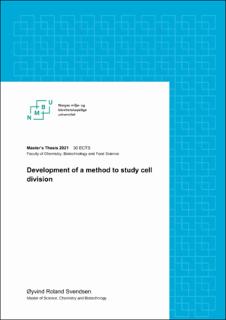| dc.description.abstract | Cell migration and proliferation play an essential role in wound healing, development, and tumorigenesis. Observing cell behavior through microscopy can give an insight to cell behavior and study cell migration and proliferation under different conditions. The aim of the present project was to develop a deep learning-based methodology for analysis of cell division and cell migration based on live microscopy data. To achieve this, a previously published experimental approach was utilized where coordinated cell migration and subsequent proliferation is stimulated in cell monolayers of the human keratinocyte cell line HaCaT (Lång et al. 2018). An automated pipeline for cell division analysis was developed by generating a deep learning model with the StarDist software.
To create a StarDist model suitable for the pipeline, several StarDist models designed to detect dividing nuclei were developed with varying training dataset sizes and parameters. The images used to generate training dataset were images acquired from live cell imaging experiments of HaCaT cells treated with serum starvation (72 h) and re-stimulation. These images were acquired with a widefield microscope. By testing the performance of the generated models on images previously not seen by the networks, the best performing model, ‘1000 2-step’, was chosen to be used in the pipeline for cell image analysis. This model was good at segmenting cell shape, with a mean matched score of 0,83201 and was moderately accurate at predicting mitotic nuclei, with an accuracy of 0,67494. Using this model, as well as a model developed by the StarDist developers, 12 time-lapse image sequences from the imaging experiments were quantitively analyzed with the developed method (Schmidt et al. 2018). The method measured the average nucleus perimeter, area, and population per frame over time. The method also measured the average mitotic cell population over time. Additionally, fixed HaCaT cells in different stages of the treatment of serum starvation and re-stimulation were IF stained with Aurora B and YAP specific antibodies were imaged with a confocal microscope. The cellular expression of these proteins gives an insight to the state of the cells in different stages of the treatment. It was found that YAP was expressed and localized in the nucleus of starved cells, indicating that starved cells are under stress. YAP is a biomechanical stress sensor which is also involved in changing the cell-cell and cell-ECM connections, and this suggests that YAP activation is involved in the increased rate of cell migration when cells are exposed to re-stimulation. The results from quantitative analyses of the image sequences and Aurora B imaging also suggests that synchronized cell division occurs around 24 hours after re-stimulation due to activation of Aurora B and the increase of mitotic cells in around this time.
In conclusion, the developed method was able to analyze cell images with moderate accuracy. Improving StarDist model accuracy is therefore the best course of action to improve the quality of the developed method. | en_US |

